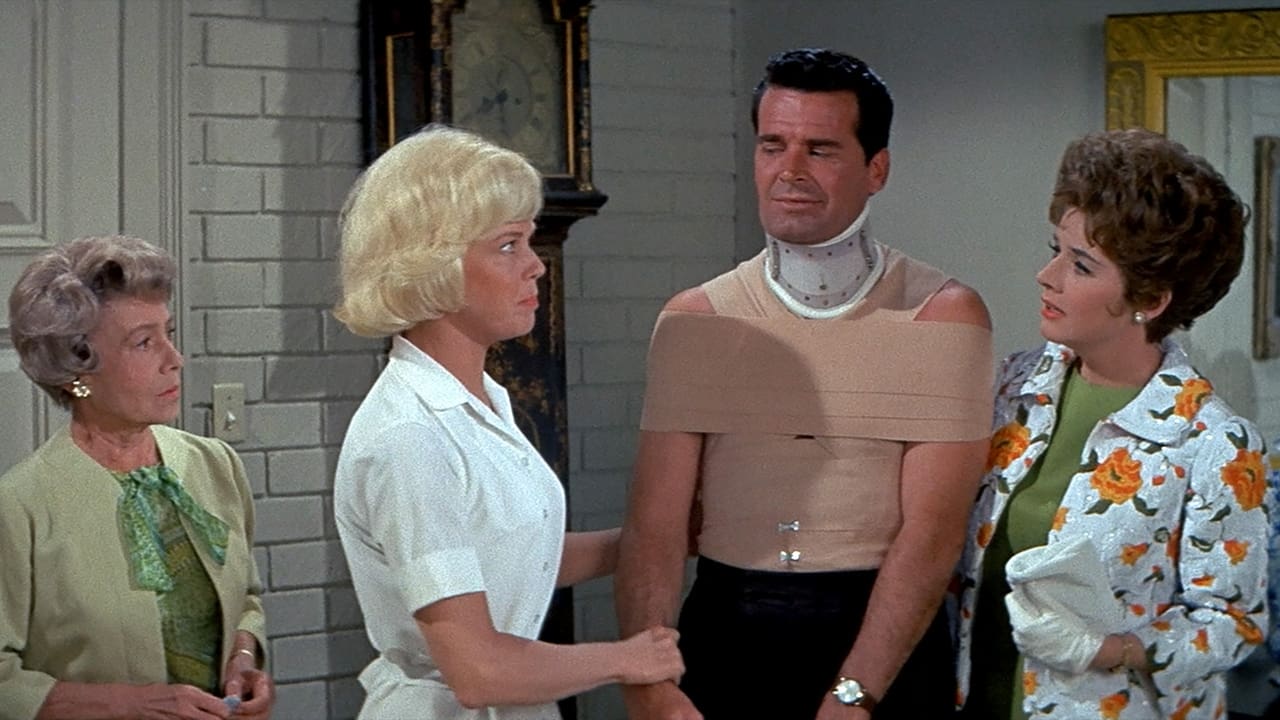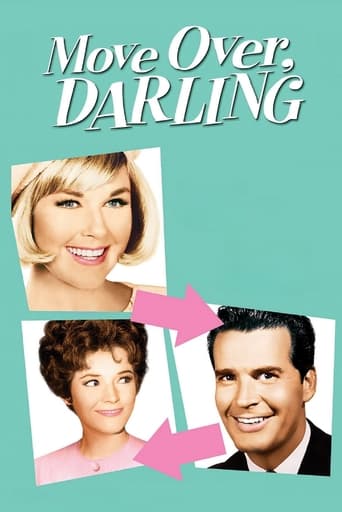

"Move Over, Darling", a remake of the 1940 screwball comedy "My Favorite Wife", had a long and difficult journey to the screen. It began life as a vehicle for Marilyn Monroe entitled "Something's Got to Give", to be directed by George Cukor. Before that film was completed, however, Monroe was fired for continually turning up late on set (or, on some occasions, not turning up at all). Lee Remick was provisionally cast as Monroe's replacement, but her co-star Dean Martin refused to work with any actress other than Monroe. Monroe was hired again, but died soon afterwards before production could restart. The studio, 20th Century Fox, had sunk too much money into the project to abandon it altogether, so went ahead with a new director (Michael Gordon), new stars (Doris Day and James Garner) and a new title. (The original title probably seemed inappropriately ironic after Monroe's tragic death).The plot is very similar to that of "My Favorite Wife", although the story is updated from the forties to the sixties. (Day's character makes a reference to having seen the earlier film as a child, although makes no reference to the strange coincidence that she and her husband have the same names as the characters in that film. The scriptwriter was probably playing games with the normal movie convention whereby remakes take place in a parallel universe in which any previous versions of the same film were never made.Like "My Favorite Wife", "Move Over, Darling" is loosely based upon Tennyson's "Enoch Arden" (hence the main character's surname). Tennyson's poem was a tragedy, but both films turn the story into a comedy. The film starts with Nick Arden about to get married for the second time. The problem is that he is legally still married to his first wife Ellen. It is presumed that she died in an air crash five years ago, but her body has never been found. The problem seems to have been solved when Nick persuades a Judge to declare Ellen legally dead, leaving him free to marry his new fiancée, Bianca. Ellen, however, is not dead at all, and has spent the last five years marooned on a desert island. Rescued by the Navy, she arrives back in America on the very day of Nick and Bianca's wedding. The film then explores the complications arising from this situation.One disadvantage of this plot line is that Nick ends up married to two different women at the same time, through no fault either on his part or on theirs. Now no film-maker in 1940 could get away with making a film openly condoning bigamy or a ménage-a-trois, and public attitudes in this respect had not shifted very much by 1963, so one of the women had to lose out. And that woman had to be Bianca; whatever the tangled legalities of the situation might be, the court of American public opinion was always going to rule in favour of Ellen who, as the mother of Nick's children, was going to be seen to have a stronger claim. So how do you make an all-ends-happily comedy when one of your main characters is a woman who, through no fault of her own, loses the love of her life? The solution found in "My Favorite Wife" is to concentrate on Ellen as much as possible and relegate Bianca to the sidelines. Here the solution is to hint subtly that Bianca is not a very nice person, a bit of a man-eater who will doubtless get over her disappointment by throwing herself at the next best man to come along.Despite its difficult birth, the movie turned out to be a box-office success, justifying Fox's decision to continue with the project after Monroe's death. It is (along with "The Sound of Music") one of the movies credited with keeping the studio afloat after the financial debacle of "Cleopatra". I would certainly prefer it to "My Favorite Wife", which I have always regarded as more cornball than screwball. The earlier film had its humorous moments, but these mostly concerned supporting characters such as the cantankerous old judge and the creepy hotel manager, obsessed with his establishment's respectability. Here the main characters join in the fun; the rivalry between Day's Ellen and Polly Bergen's Bianca has a lot more edge to it than that between the rather treacly Irene Dunne and the anonymous Gail Patrick. I particularly liked the scene where Ellen, posing as a Swedish masseuse, gives her rival an over-vigorous massage which turns into a catfight.Doris Day's "virginal" reputation was starting to slip a bit by the early sixties; in "Lover Come Back" from two years earlier she had played an unmarried mother. Even in her early forties, however, she still counted as one of America's sweethearts, and a lot of the success of the film owes something to this aspect of her character. She was the sort of actress who could sing a song (as she does in the title song to this movie) containing the line "Make love to me!" and still come across as sweet and wholesome. It would be interesting to speculate how Marilyn would have played the role had "Something's Got to Give" been completed. 7/10
... View MoreThis movie is a remake of My Favorite Wife, starring Cary Grant and Irene Dunne, which I gave a 10 to. It's been a while since I've watched it the latter though, and at first I was hard-pressed to understand why I felt I liked it better than this remake, but it soon enough came to me.Both movies are vehicles of their leading ladies and tailored to suit their characters. Hence, with Doris Day, there is more slapstick humor and her character comes across as more "cutely" petulant. Irene Dunne is classier and she has an air of benevolence. Now I love Day but with this story, I feel that Dunne's character is more appropriate. And of course Cary Grant is more charismatic than James Garner, even if the latter is pretty hot in this movie.What Move Over has going for it is the queen of wisecracking supporting actresses, Thelma Ritter, who is as fun here as any of her other movies. Also, without the disadvantageous comparison to My Favorite Wife, this movie is a charming enough romantic comedy in itself.
... View MoreAs you may know, "Move Over Darling" is a remake of the Cary Grant/Irene Dunne film "My Favorite Wife." This film copies the original almost scene-for-scene, with a few changes. I'm torn on which film is better all around, but this version fixes a few things that bothered me about the original. First of all, the reunion between the two main stars at the hotel toward the beginning is more romantic and emotional here. Also, I didn't like the ending of the original film, which felt tagged on and unsatisfying, whereas the ending to this film wrapped everything up nicely and pleasantly. This film has much better co-stars, including Don Knotts and Thelma Ritter. The only reason I do not say for sure that this film is better than the original is the fact that the original was a very funny film, which is not to say that this is unfunny, but the comedy simply doesn't measure up to the brilliance of Cary Grant. I recommend both versions, and while the original provided more laughs, this gives more emotional satisfaction, but both are enjoyable. Just don't watch them side-by-side or you may feel like you just saw the same film twice.*** out of ****
... View MoreThis might have been a lot different were it called "Something's Got to Give" had Marilyn Monroe not been sacked from what might or might not have been her final film. So many 'what if's'. Instead, it became a vehicle for Doris Day, playing the part Irene Dunne played in "My Favourite Wife", of which this is a mildly entertaining, mildly funny remake. None of it rings true, but then farces usually don't and this is a farce which is why we wish it were funnier.In this one Day is chirpy rather than starchy but is prone to mugging, (something she was inclined to do from time to time). The husband who has just remarried, (Day has 'come back from the dead'; she was marooned on a desert island, presumed drowned), is James Garner who was a much finer comedian than he was given credit for. Polly Bergen, looking uncomfortable, is the new wife and Thelma Ritter, as ever, steals the picture as the mother-in-law.
... View More